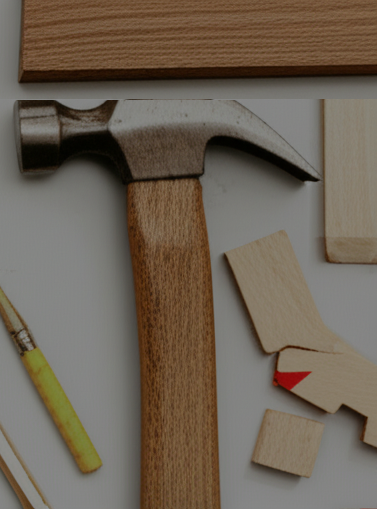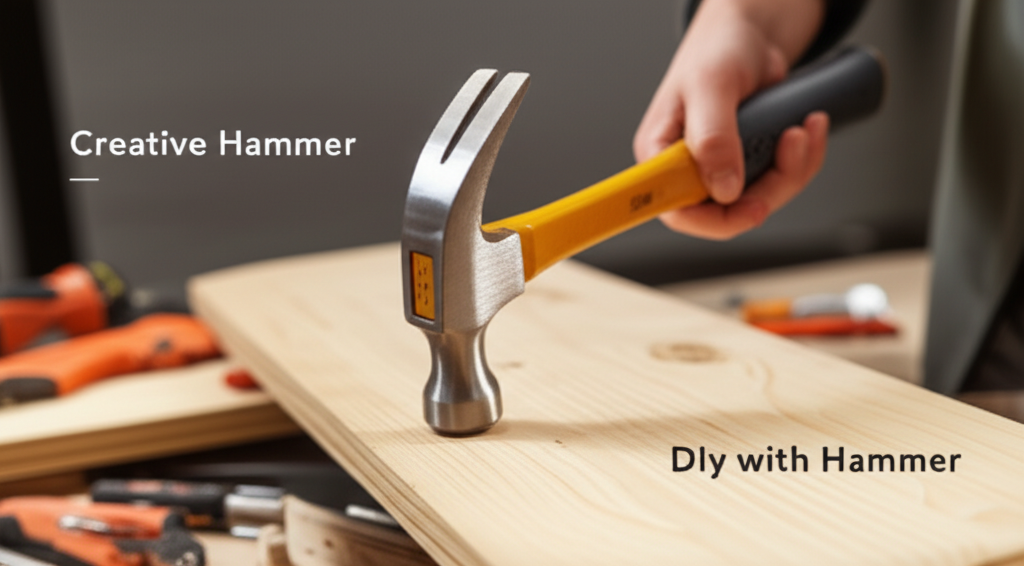Introduction: The Hammer – More Than Just a Tool
When you think of a hammer, your mind likely conjures images of construction workers driving nails, framing houses, or perhaps even a DIY enthusiast tackling a weekend furniture assembly. It’s a tool so ubiquitous, so fundamental, that its primary function often overshadows its immense potential for creative expression. But what if we shifted our perspective? What if the hammer, in its elegant simplicity, is actually a versatile instrument capable of transforming raw materials into artistic statements? This article delves into the often-overlooked world of using a hammer for creative home projects, exploring its capabilities beyond traditional construction and inspiring you to pick up this timeless tool for your next artistic endeavor. From delicate wood carving to striking metalwork, the hammer offers a unique tactile experience and a direct connection to the material, allowing for an unmediated, powerful form of creation. We’ll explore various techniques, project ideas, and essential considerations to help you harness the creative force of the hammer.
Must-Have Tools in Your House If You Work Regularly
Understanding the Hammer: Anatomy of a Creative Tool

Before we embark on creative journeys, a brief understanding of the hammer’s anatomy is crucial. Different types of hammers are designed for specific tasks, and choosing the right one can significantly impact your creative outcome.
Common Hammer Types and Their Creative Applications
- Claw Hammer: The workhorse of carpentry, its primary function is driving nails, but the claw can be used for prying, scraping, and even creating textured effects in softer materials.
- Ball-Peen Hammer: Characterized by its rounded peen, this hammer is ideal for shaping metal, rounding edges, and creating decorative dimples in metal projects.
- Mallet (Rubber, Plastic, Wood): Softer than steel hammers, mallets are excellent for striking chisels without damaging the handle, assembling delicate wooden pieces without marring surfaces, and even for certain types of wood bending or shaping.
- Sledgehammer: While a powerful demolition tool, a controlled swing can be used for larger-scale sculptural work, breaking down materials in a controlled manner, or for dramatic textural effects on robust surfaces.
- Chasing Hammer: A lighter hammer with a flat, polished face, specifically designed for metal chasing and repoussé work, allowing for intricate detailing and shaping.
Creative Project Ideas: Where Hammer Meets Art
The possibilities are as boundless as your imagination. Here are several categories of creative projects where a hammer can be your primary artistic tool.
Woodworking and Carving
While traditional carving often involves chisels, a hammer can be integrated in several ways:
- Texturizing Wood: Using the claw of a hammer or even the side of the ball-peen hammer, you can create unique textures on wooden surfaces. Experiment with different angles and pressures to achieve varied effects, from rough, distressed looks to subtle, rhythmic patterns.
- Wood Bending: With the aid of a mallet and some strategic tapping, you can gently persuade wood into curves. This is particularly effective with thinner strips of wood and can be an integral part of creating sculptural forms or decorative elements for furniture.
- Creating Wood Relief: Instead of removing material, you can use a hammer and specialized wood carving tools (like gouges or chisels) to create raised designs. The hammer’s force amplifies the chisel’s action, allowing for deeper and more pronounced relief.
Metalworking and Jewelry Making
The malleability of metal makes it a prime candidate for hammer-based artistic manipulation.
- Metal Texturing: Using ball-peen, chasing, or even a standard claw hammer, you can create a wide array of surface finishes on sheet metal. Stippling, hammering lines, creating patterns of dents, or even doming techniques are all achievable with controlled hammer strikes.
- Jewelry Forming: From shaping wire to creating hammered textures on pendants and earrings, a small ball-peen or chasing hammer is invaluable in jewelry making. You can flatten, dome, or add intricate patterns to metal components.
- Repoussé and Chasing: This ancient art form involves pushing metal from the back (repoussé) and then refining the detail from the front (chasing) using specialized hammers and punches. The hammer is the engine of this intricate shaping process.
Mixed Media and Sculptural Art
The hammer’s versatility extends to combining different materials and creating three-dimensional works.
- Assembling Assemblages: For projects involving found objects or disparate materials, a hammer can be used to secure elements, create connections, or even add decorative impressions to surfaces before or after assembly.
- Concrete and Stone Art: While requiring careful control, a hammer can be used to chip away at softer stones or concrete to create sculptural forms or decorative surfaces. Smaller, controlled strikes with a lighter hammer can achieve intricate details.
- Creating Soundscapes: Consider a project where the hammer itself, or the act of hammering, becomes part of the art. Perhaps a kinetic sculpture that is activated by striking tuned metal or wooden elements.
Essential Considerations for Creative Hammering
Safety and technique are paramount when wielding a hammer for artistic purposes. The power of this tool demands respect and a mindful approach.
Safety First: Protecting Yourself and Your Workspace
- Eye Protection: Always wear safety glasses or goggles to protect your eyes from flying debris, regardless of the material you are working with.
- Hearing Protection: For prolonged hammering or when working with metal, earplugs or earmuffs are essential to prevent hearing damage.
- Work Surface Protection: Use a sturdy workbench or a heavy-duty mat to protect your underlying surfaces from damage.
- Proper Grip and Stance: Maintain a firm but relaxed grip on the hammer. A stable stance will provide better control and reduce the risk of accidents.
- Material Stability: Ensure the material you are hammering is securely clamped or supported to prevent it from shifting during impact.
Developing Technique: Precision, Control, and Intent
The difference between destructive force and creative expression lies in technique.
- Start Small: Begin with smaller, less critical projects to practice different hammer types and striking techniques.
- Vary Your Grip: Experiment with holding the hammer closer to the head for more control and precision, and further down the handle for more power.
- Controlled Swings: Focus on smooth, controlled swings rather than brute force. Let the momentum of the hammer do the work.
- Listen to the Material: Pay attention to the sound and feel of the hammer striking the material. This feedback is crucial for understanding how the material is responding and for refining your technique.
- Practice Different Striking Surfaces: Experiment with hitting the material with the flat face, the peen, or even the side of the hammerhead to achieve different visual and textural effects.
Key Facts and Comparisons in Creative Hammering
Understanding how different hammers interact with various materials is key to successful creative projects.
| Hammer Type | Primary Creative Application | Material Suitability | Level of Control | Typical Sound |
|---|---|---|---|---|
| Claw Hammer | Wood texturing, light wood shaping | Wood, soft metals | Moderate | Thud, scrape |
| Ball-Peen Hammer | Metal texturing, shaping, jewelry | Metals (copper, brass, silver, steel) | High | Ping, ring |
| Mallet (Rubber/Plastic) | Chisel striking, gentle shaping, assembly | Wood, softer plastics, delicate assemblies | Very High | Thump, dull thud |
| Sledgehammer | Large-scale sculpting, material breaking | Stone, concrete, large wood pieces | Low (requires significant control) | Resounding boom |
| Chasing Hammer | Intricate metal detailing, repoussé | Thin metals, precious metals | Extremely High | Sharp, clear ping |
Pros and Cons of Using a Hammer Creatively
Every tool has its advantages and disadvantages, and the hammer is no exception when applied to artistic pursuits.
| Pros | Cons |
|---|---|
| Direct Tactile Feedback: Offers an immediate and visceral connection to the material. | Potential for Over-Impact: Easy to apply too much force, leading to unintended damage or destruction of the piece. |
| Versatility: Can be used on a wide range of materials from wood to metal to stone. | Noise: Hammering can be a noisy activity, requiring consideration for neighbors or shared living spaces. |
| Accessibility: Hammers are relatively inexpensive and widely available. | Learning Curve: Developing precise control and artistic technique takes practice and patience. |
| Unique Textures: Allows for the creation of distinctive surface treatments not easily achieved with other tools. | Safety Risks: Requires careful attention to safety protocols to avoid injury. |
| Empowering: The physical act of creation can be incredibly rewarding and empowering. | Material Limitations: Certain very hard or brittle materials may not be suitable for hammer-based creative work. |
Conclusion: The Hammer as a Muse
The hammer, often relegated to the utilitarian realm of construction, is a powerful and surprisingly versatile tool for creative home projects. By understanding its different forms, embracing safe practices, and developing a nuanced technique, you can unlock a new dimension of artistic expression. Whether you’re adding unique textures to a wooden bowl, shaping a piece of metal jewelry, or even embarking on a sculptural endeavor, the hammer offers a direct, tactile, and ultimately deeply satisfying way to bring your creative visions to life. So, the next time you reach for a tool, consider the humble hammer not just for its ability to drive a nail, but for its potential to strike inspiration and shape your next masterpiece. Step outside the conventional, embrace the percussive rhythm of creation, and let the hammer be your muse.







